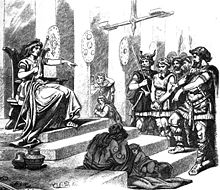Forseti


Forseti(Old Norse"the presiding one", "president"in modernIcelandicandFaroese) is thegodof justice and reconciliation inNorse mythology.He is generally identified withFosite,a god of theFrisians.
Name
[edit]Grimm tookForseti,"praeses, princeps",to be the older form of the name, first postulating theOld High Germanequivalent*forasizo(cf. modern GermanVorsitzender"one who presides", Old Englishfore-sittan'to preside').[1]but later preferring a derivation fromfors,a "whirling stream" or "cataract", connected to the spring and the god's veneration by seagoing peoples.[2]It is plausible thatFositeis the older name andForsetiafolk etymology.[3]According to the GermanphilologistHans Kuhn the Germanic form Fosite is linguistically identical to GreekPoseidon,hence the original name may have been introduced before theProto-Germanicsound change,possibly via Greek sailors purchasingamber(cf.Pholas a cognate ofBaldr).[4][5]The etymologist Wolfgang Laur, is highly critical, however, as the names of Germanic gods are composed almost exclusively of Germanic components. According to Laur, the name Forseti remains largely unexplained.[6]
Old NorseForseti
[edit]According toSnorri Sturlusonin theProse Edda,[7]Forseti is the son ofBaldrandNanna.His is the best of courts; all those who come before him leave reconciled. This suggests skill inmediationand is in contrast to his fellow godTýr,who "is not called a reconciler of men."[8]However, asde Vriespoints out, the only basis for associating Forseti with justice seems to have been his name; there is no corroborating evidence in Norse mythology.[9]'Puts to sleep all suits' or 'stills all strifes' may have been a late addition to the strophe Snorri cites, from which he derives the information.[10]
The first element in the nameForsetlund(Old NorseForsetalundr), a farm in the parish ofOnsøy('Odin's island'), in eastern Norway, seems to be the genitive case of Forseti, offering evidence he was worshipped there.[10][11]
Glitnir
[edit]Glitnir(meaning "one who shines" )[12]is the hall of Forseti, and the seat of justice amongstgodsand men. It is also noted to have been a place of dwelling forBaldr,Forseti's father in Norse andGermanic mythologies.Glitnir is symbolic of the importance of discussion rather than violence as a means of resolution of conflict within the Norse tradition. It has pillars ofgoldand is roofed withsilver,which radiated light that could be seen from a great distance.[13]The stories of Baldr and his son Forseti may have been contaminated with legends about kingGuðmundrand his son Höfundr ('the judge'), who inhabited theotherworldland ofGlæsisvellir.
FrisianFosite
[edit]According toAlcuin's Life ofSt. Willebrord,the saint visited an island between Frisia and Denmark that was sacred to Fosite and was called Fositesland after the god worshipped there. There was a sacred spring from which water had to be drawn in silence, it was so holy. Willebrord defiled the spring by baptizing people in it and killing a cow there.[10]Altfridtells the same story ofSt. Liudger.[14]Adam of Bremen retells the story and adds that the island wasHeiligland,i.e.,Heligoland.[15]
There is also a late-medieval legend of the origins of written Frisian laws. Wishing to assemble written lawcodes for all his subject peoples,Charlemagnesummoned twelve representatives of the Frisian people, theasega's('law-speakers'), and demanded they recite their people's laws. When they could not do so after several days, he let them choose between death, slavery, or being set adrift in a rudderless boat. They chose the last and prayed for help, whereupon a thirteenth man appeared, with a golden axe on his shoulder. He steered the boat to land with the axe, then threw it ashore; a spring appeared where it landed. He taught them laws and then disappeared.[16][17]The stranger and the spring have traditionally been identified with Fosite and the sacred spring of Fositesland.
This hypothesis has not met with universal acceptance.[18]
Reception
[edit]Jacob Grimmnoted that if, asAdam of Bremenstates, Fosite's sacred island wasHeligoland,that would make him an ideal candidate for a deity known to both Frisians and Scandinavians, but that it is surprising he is never mentioned bySaxo Grammaticus.[19]
In modern culture
[edit]The GermanneofolkbandForsetinamed itself after the god.[20]
In the 2002Ensemble StudiosgameAge of Mythology,Forseti is one of 9 minor gods Norse players can worship.[21][22][23]
See also
[edit]References
[edit]- ^Grimm,p. 231.
- ^Grimm,p. 232, note 2;volume 4 (Supplement, 1883)p. 1360.
- ^Jan de Vries,Altgermanische Religionsgeschichte,volume 2, 2nd ed. Berlin: de Gruyter, 1957, repr. 1970, p. 283(in German).
- ^Hans Kuhn,Kleine Schriften IV: Aufsätze aus den Jahren 1968-1976,ed. D. Hofmann, Berlin/New York 1978, p. 186-188.
- ^Ludwig Rübekeil, "Scandinavia in the Light of Ancient Tradition", translated by James E. Cohen, inThe Nordic Languages,ed. Oscar Bandle et al., Walter de Gruyter, Berlin and New York. 2002. p. 598.
- ^Wolfgang Laur,Germanische Heiligtümer und Religion im Spiegel der Ortsnamen: Schleswig-Holstein, nördliches Niedersachsen und Dänemark,Neumünster 2001, p. 84.
- ^Gylfaginningch. 32: text and translation online atvoluspa.org.
- ^Gylfaginningch. 25, tr.Arthur Gilchrist Brodeur,online atvoluspa.org.
- ^De Vries, p. 283.
- ^abcHilda R. Ellis Davidson,Gods and Myths of Northern Europe,London: Pelican, 1964, repr. Penguin, 1990,ISBN0-14-013627-4;repr. asGods and Myths of the Viking Age,New York: Bell, 1981,ISBN0-517-33644-8,p. 171.
- ^E.O.G. Turville-Petre,Myth and Religion of the North: The Religion of Ancient Scandinavia,London, Weidenfeld, 1964, p. 238.
- ^Guðrún Kvaran."Hvað merkir orðið Glitnir og hvaðan er það upprunnið?".Vísindavefurinn(in Icelandic).Retrieved2020-03-27.
- ^"Grimm's TM - Chap. 11".Northvegr. Archived fromthe originalon 2008-05-17.Retrieved2018-05-24.
- ^De Vries, p. 282.
- ^Gesta Hammaburgensis ecclesiae pontificumBook IV (Descriptio insularum aquilonis), ch. 3.
- ^Ellis Davidson, pp. 171-72.
- ^Thomas L. Mackey,Frisian,Trends in Linguistics, The Hague: Mouton, 1981,ISBN90-279-3128-3,pp. 63-64calls this "the king Karl and King Redbad episode" and notes there are several versions.
- ^Willy Krogmann, 'Die friesische Sage von der Findung des Rechts', in:Zeitschrift für Rechtsgeschichte, Germanische Abteilung84 (1967), pp. 72-127.
- ^Jacob Grimm,Teutonic Mythology,tr. James Steven Stallybrass, volume 1 London: Bell, 1882,p. 231.
- ^Andreas Diesel, Dieter Gerten. Looking for Europe: Neofolk und Hintergründe. Index Verlag 2007. p. 217ISBN978-393687802-8
- ^"The Minor Gods: Norse - Age of Mythology Wiki Guide - IGN".27 March 2012.
- ^"Age of Mythology".
- ^"Age of Mythology Reference Manual".
